In September, 2009, I posted a review of the new Sony Touch Edition reader (PRS-600). That reader has a touch screen, dictionary, note-taking abilities, and it retails for $299.99. It’s a fabulous reader, but it does have a problem with screen glare. It’s also expensive and has some features that many people don’t want to pay for. At the same time the Touch Edition reader was released, Sony also introduced the Pocket Edition reader (PRS-300). At $199.99, it’s Sony’s least expensive reader. The Pocket Edition is the smallest reader offered by Sony, and some people may consider it a stripped down, entry-level reader. Other people may consider it the reader they’ve been looking for. Let’s give it a closer look.

What’s in the box:
Sony Pocket Edition reader
USB sync/charging cable
Padded sleeve
Quick start guide
Specifications:
5-inch (diagonal) Vizplex ™ E-ink® screen
Dimensions: 6.25 X 4.25 X 0.41 inches
Weight: 7.76 oz
Memory: 512 MB, with 440 MB user-accessible
8-levels gray-scale with 800 X 600 pixel resolution
Rechargeable lithium-ion battery
Media formats supported: ePub (Adobe DRM protected), PDF (Adobe DRM protected), BBeB Book (PRS DRM protected), ePub, BBeB Book, PDF, TXT, RTF, Microsoft Word (conversion to the Reader requires Word installed on your PC)
Connectivity: USB for file transfer from PC
Power: charge with USB cable (supplied) or optional AC adapter
Works on both Windows and Mac computers
There is no installation disk with the reader; installation files are on the reader itself and should be installed when you connect your reader the first time. I was already running the latest version of the Sony Reader Library software, and I was able to load up books as soon as the device driver installed on my computer (64-bit Windows Vista Home Premium).
The Pocket reader, like the 600, is missing a cover. Sony provided a spongy sleeve for the reader, but it doesn’t seem very protective to me. The top is open, to slide the reader in, and there is no way to close the sleeve. The foam padding isn’t very dense, and I worry that this sleeve won’t provide enough protection if you have the reader in your purse or gear bag.
The body of the Pocket reader appears to be aluminum. It is available in silver, navy blue, and rose. The cost-cutting measure that I think is most noticeable is the lack of the chrome-colored accents. The top/bottom/right edge of the reader is made of plastic, and the color coordinates with – but doesn’t match – the body color. I think that’s a little chintzy, but it’s certainly no deal breaker. The back of the reader has a slightly rubbery feel, apparently to give you a better grip on the naked reader. The small form makes the Pocket Edition surprisingly easy to hold. My thumb can easily reach the page advance button, so one-handed reading would be a snap. I prefer using a book-style cover on my readers, so I purchased the optional Sony premium cover. You can see it on the reader in the top picture. And yes, you can bend the premium cover all the way back for one-handed reading, but that does make it a bit harder for my thumb to reach the page turn button. People with longer fingers shouldn’t have a problem.

The most significant differences between the Pocket Edition and the Sony 600, 505, and 500 models are in the things that have been removed. The Pocket Edition doesn’t have any expansion card slots, it doesn’t have an mp3 player, and it doesn’t support image files. None of those things present a problem for me. The internal memory is sufficient to hold hundreds of books, certainly enough to keep me happy until I can get to my computer to add more. (The Pocket Edition doesn’t have wireless access.) It doesn’t display image files, but you’ve got to admit that 8-level gray scale isn’t the best way to show off your photos. And as for the missing mp3 player? I never wanted one of those in any of my Sony readers anyway. I hated having to pay the extra cost for something I’d never use, and I hated having to worry about accidentally hitting the volume rocker. It may have been my imagination, but I felt that messing with the volume rocker shortened my battery life.

Speaking of the battery, the Pocket Edition has a rechargeable lithium-ion battery. Sony provides a USB cable that is used for syncing and charging your reader. I recommend that you get yourself an AC adapter. Not only does the AC adapter charge faster, but many people feel that it provides a better, fuller charge – especially when the battery has been completely drained. You can buy the $30 official AC charger for Sony Digital Books, or you can pick up a charger for the Sony PSP – it works fine. Apparently the AC adapters with USB cables don’t work for Sony readers, as reported by many readers on the MobileRead forums.
Sony still reports battery life as “page turns”. This is misleading. Most power consumption occurs when the page “turns”, but the battery does continually drain while the reader is on or in standby. The power switch simply puts the reader in standby – clears the screen and disables all buttons but the power slider. You can extend battery life with the device shutdown option in settings. I never shutdown my readers, and I’ve gotten 2-3 weeks, reading 3-4 hours a day, with every Sony reader I’ve owned. I’ve only played around with the Pocket Edition reader for a couple of days, but I’d be surprised if the battery didn’t last just as long.
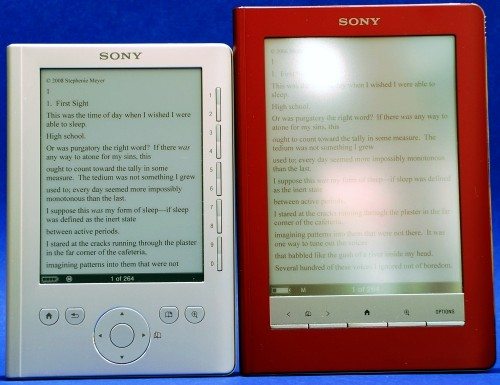
The Pocket Edition reader doesn’t have a touch screen. When compared to the Touch Edition reader, the Pocket reader screen doesn’t have any glare. Its screen also has higher contrast, which many people will find easier to read. However, no touch screen means that there is no dictionary lookup and no note-taking abilities.
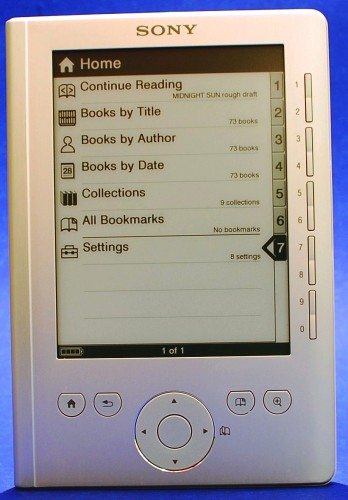
No touch screen also means the Pocket Edition has control buttons. The number rockers along the right side of the screen have a couple of functions. They are used to select options in menu screens, and they are used to enter a page number to navigate to while reading a book. The rest of the control buttons are below the screen. There is a “home” button that returns you directly to the home menu – something neither the 505 nor the 500 readers had. There is a back button to take you to the previous level. The button showing a book with a dog-eared page creates/removes a bookmark. The magnifying glass button changes font size. The Pocket Edition has three font sizes, small/medium/large, and this button toggles through the sizes.
The center navigation button has the enter button in the center; use it to select the highlighted menu option. The outer ring has the up/down/page back/page forward buttons. The up/down buttons move the cursor in the menus.
The Pocket Edition has a faster processor than previous models. Page changes are noticeably faster than on my old 505, and I noticed that it seems to respond quicker when I’m loading up books from the Sony Reader Library software.
The Sony Reader Library software allows you to drag-and-drop books on the Pocket Edition reader. You can organize books on your reader with “collections”. Collections are like folders, but no sub-folders are allowed. They are virtual, so you need only a single copy of the book, but it can be in multiple collections.
The 300 reader handles all the same formats as its bigger siblings. In the picture with the 600 (above), both readers are using their medium font to display the same page from a text-only PDF file. Naturally, the Pocket’s screen is smaller, so it can’t display quite as much of the page as the 600. Both readers can reflow PDF files, but the Pocket edition has no pan-and-scan option like the 600 does. The Pocket Edition also has the same page-numbering quirk – showing the same page number until all the text from that page has been displayed. I have included some pictures showing how the Pocket reader handles PDF files with images. The entire page is displayed when the small font is chosen. You can see the page layout, and you can see small versions of images on the page. When you move to medium and large fonts, it’s much easier to read the text, but the images don’t display properly – or at all. (Click on the following pictures for more detail.)
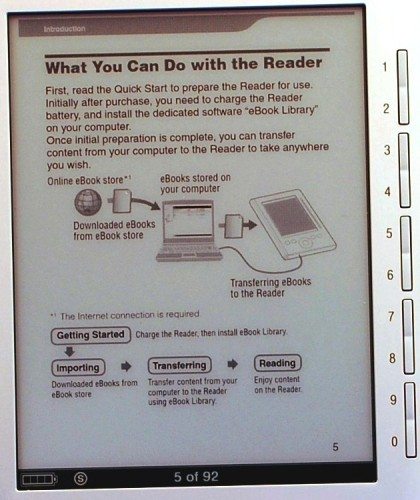
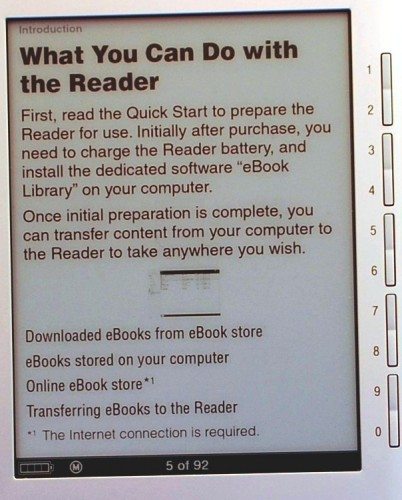
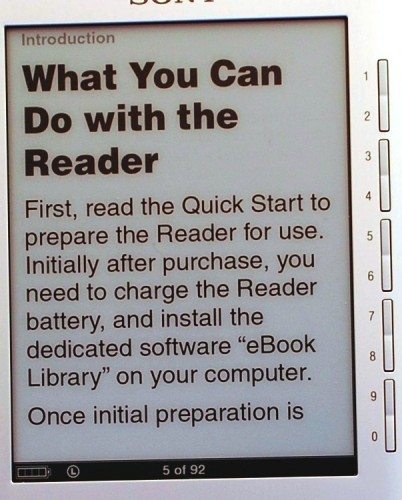
You can also read ePub files (with Adobe DRM, or DRM-free), the proprietary Sony BBeB format, and a variety of other formats listed in the specifications above. You can buy books from the Sony ebook store, but you are not limited to it. You can use books from Project Gutenberg, Google Books, and you can check out ebooks from libraries. The Sony Reader Library software can help you locate local libraries that offer ebooks.
The Sony Pocket Edition is a simple ebook reader and the price positions it as an entry-level reader, but it doesn’t seem to be missing anything important. The sharp, clear eInk screen lets you read for hours without the eyestrain you can get from backlighted LCD screens. The compact form makes it easy to hold and easy to fit in your gear bag, purse, or even a pocket. The controls are easy to reach and simple to use. It’s a great ebook reader for a child, and it’s an equally great reader for adults who want a small format and don’t need a lot of bells and whistles.
Gerber Gear 22-47162N Fast Draw Folding Assisted Opening Pocket Knife, Fine Edge, Black
$42.76 (as of December 6, 2025 17:58 GMT -05:00 - More infoProduct prices and availability are accurate as of the date/time indicated and are subject to change. Any price and availability information displayed on [relevant Amazon Site(s), as applicable] at the time of purchase will apply to the purchase of this product.)Gerber Gear EVO Jr. Folding Knife - Serrated Edge [22-41493]
$28.99 (as of December 6, 2025 17:56 GMT -05:00 - More infoProduct prices and availability are accurate as of the date/time indicated and are subject to change. Any price and availability information displayed on [relevant Amazon Site(s), as applicable] at the time of purchase will apply to the purchase of this product.)Product Information
| Price: | $199.99 |
| Manufacturer: | Sony |
| Pros: |
|
| Cons: |
|



Gadgeteer Comment Policy - Please read before commenting
This is a great review as it told me something I didn’t know, specifically that the more advanced models do play mp3 files.
As someone who also avidly listens to audio books, I will have to make sure that I can listen to those on a Sony Reader. Or check out if I can on the Kindle.
This makes the product much more useful.
Folks looking for a fine, even less expensive ebook solution might want to check out the Ectaco Jetbook Lite. It uses a very readable and responsive lcd screen instead of e-ink, supports a variety of formats including Barnes & Noble DRM and mobipocket, takes rechargeable or regular AA batteries — and costs just $150.
I’m liking my nook, but find the screen, slightly too small, I’d really be worried about going even smaller. 5″ Wow, but then again, I’m no longer in my 20’s and my eyes are not as good. 10 years ago this might have been ideal.
@Andrew The font on the Sony Pocket reader seems to be the same size as the small/med/large fonts used by the Sony 600 Touch reader. You just need to do a few more page turns. My eyes are no longer in their 20s and I had no trouble reading with the smaller screen.
The red edition screams “Etch-A-Sketch!”
I am quite pleased with the Pocket reader with two notable exceptions. The Sony store is linked to Borders which I thought would be the equal of Amazon or B&N. In reality, it is not, and offers a much more limited selection of eBooks for purchase. Also, not noted in your review is the fact that you can’t have ePub and PDF books on the reader at the same time. In order to switch formats, you must offload to the library. A major pain.
I bought the Sony Pocket reader for my neice, and I’ve already given it to her so I can’t check this now. However, I had ePubs and PDF files both on the Pocket reader and had no problems. I have heard that some people experienced problems when they had both ePub and PDF files they had checked from from a public library at the same time. The MobileRead wiki file has information about the problem with the lending-library files. http://wiki.mobileread.com/wiki/Sony_Reader_Troubleshooting_Guide
Sony online help also says the PDF and ePub problem exists with lending-library books. http://ebooks.custhelp.com/app/answers/detail/a_id/190/session/L3NpZC9ITDN3ZnJXag%3D%3D/sno/0
I also own the Sony eBook Reader Pocket Edition (what a mouthful). I like the compact form factor and like Janet, I don’t care for MP3 player or other gimmicks. I do wish that the reader comes with a dictionary which is super handy since English is not my native language.
What I don’t like about the reader is not the reader itself, but the software: it often hangs when I sync, and keeps forgeting the window size I set.
Get Calibre (google it) an alternative library software that enhances this reader a great deal. It can convert formats and do a lot of other things and is much better than the Sony software. It was developed for Sony e-readers but now supports many kinds. Read the FAQ on the Calibre site. It’s FREE software, but you should make a donation as it darn good stuff.
It will allow you to use other formats with your Sony, better manage your library and it does not freeze up. 😉
I looked at the Sony pocket Edition when I was looking for a smaller reader (I had a Bookeen Cybook Gen3 at that point ) and decide against it due to the compromises such as limited format support and no SD card..
I instead went with the Astak EZreader Pocket Pro (http://www.theezreader.com/) , which is similer in size to the Sony but supports more formats, Has a SD card and User replaceable battery. Best of all its also priced at $199 so you get a lot more for the same money.
Astak also includes a Case with the reader which you’ll need to buy for the Sony, meaning you spend another $20-30.
While the User interface on the Sony is more polished, I’ve found that the Pocket pro is pretty easy to use and meet all my needs
While I used to Own a Sony PRS-500 and still like the look and feel of its successors, I currently find that with my library spread over in multiple formats it make more sense to get a reader which supports them all so that I don’t have to worry about which file will work on which device.